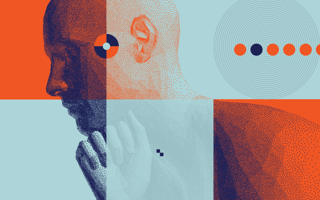To say generative AI has made a splash recently would be an understatement. And local design leaders have taken notice.
Within five days of its release, the conversational AI tool ChatGPT reached one million users. In two and a half months, image generator DALL-E crossed the same milestone.
Meanwhile, GitHub’s Copilot — a programming assistant for developers — reached 400,000 users within a month following its release.
These tools, and their ability to cross from the analytical realm of yesteryear’s AI into the creative landscape, have sparked heated debates over ethical concerns of ownership and privacy and philosophical discussions over the very basis of imaginative inspiration and artistic integrity.
Generative AI vs. Traditional AI
Traditional AI could take a mountain of data and detect patterns, automate processes and make predictions. Generative AI, on the other hand, can learn from data and create something entirely new.
While some see the rapid adoption and development of generative AI as a threat, others have found that these tools can become a symbiotic partner in the creative process.
“It’s an exciting time to be creating products, and designers have the potential to shape a future where innovation and creativity intertwine harmoniously with artificial intelligence,” said Design Lead Robyn Lambert, who works at digital product agency Work & Co.
As designers seek to assess the impact of AI on their field and integrate it into their workflows, Lambert offered a glimpse into how it can become a supplemental force in the design process.
Work & Co is a technology and design partner for companies like Google, IKEA, Apple and more that defines and launches digital products.
Give us some background on your experience and what you do in your current role at your company.
I’m a design lead at Work & Co with over seven years of experience creating innovative digital products. Throughout my career, I have had the privilege of collaborating with renowned clients such as Uber, Nike, Verizon, Home Depot, FRAME and Acorns.
Since the beginning of 2023, my focus has been on a number of compelling projects using AI. While designing these products, our team has tested the possibilities of utilizing cutting-edge AI and natural language processing technologies within the retail, hospitality and travel sectors. It’s rewarding to explore the potential of these new tools and discover how AI can transform these industries and deliver better experiences to customers.
In your opinion, what impact will AI have on the future of design as a profession? Will AI tools replace design professionals, supplement the work or do something else?
AI will likely push forward and evolve the day-to-day role of designers — particularly digital product designers. New AI design tools can streamline our approach to the design process. Instead of manually creating each layer, image or text item, we will now integrate AI tools that co-create designs alongside us, enabling us to produce high-fidelity designs in a shorter time frame. Designers will regain time to focus on evaluating, critiquing and fine-tuning the designs that AI generates. We may also be tasked with keeping the user at the center of every product, by considering how users will interact with the product, its potential value in their lives and how well it aligns with business objectives.
At Work & Co, we’re exploring all the ways to harness the power of AI, resulting in applications across various industries like retail and travel. I’m hopeful that AI could unlock a future where computers intuitively adapt to humans, and designers will play a central role in making that possible.
I’m hopeful that AI could unlock a future where computers intuitively adapt to humans, and designers will play a central role in making that possible.”
What do you think design professionals should do now to prepare for the integration of AI into workflows?
To have an influence on the future of AI products, designers should actively engage in conversations around AI and participate in AI exploration within our organizations. By joining the teams responsible for ideating and creating AI products today, we can play a role in shaping a more humane AI landscape in the future and infuse these technologies with a thoughtful consideration of user well-being.
As designers, our skills and creativity can easily translate to creating concepts for AI products. We think critically about digital products every day — designing for AI will not be very different. I believe embracing AI technology will open up exciting new possibilities and provide us with a new playground to explore.
Be open-minded and ready for change. Remaining curious and adaptable will allow designers to stay in touch with the rapidly evolving landscape of AI. Eagerly embracing new and emerging possibilities will contribute to transformative innovation in user-centered design solutions.






